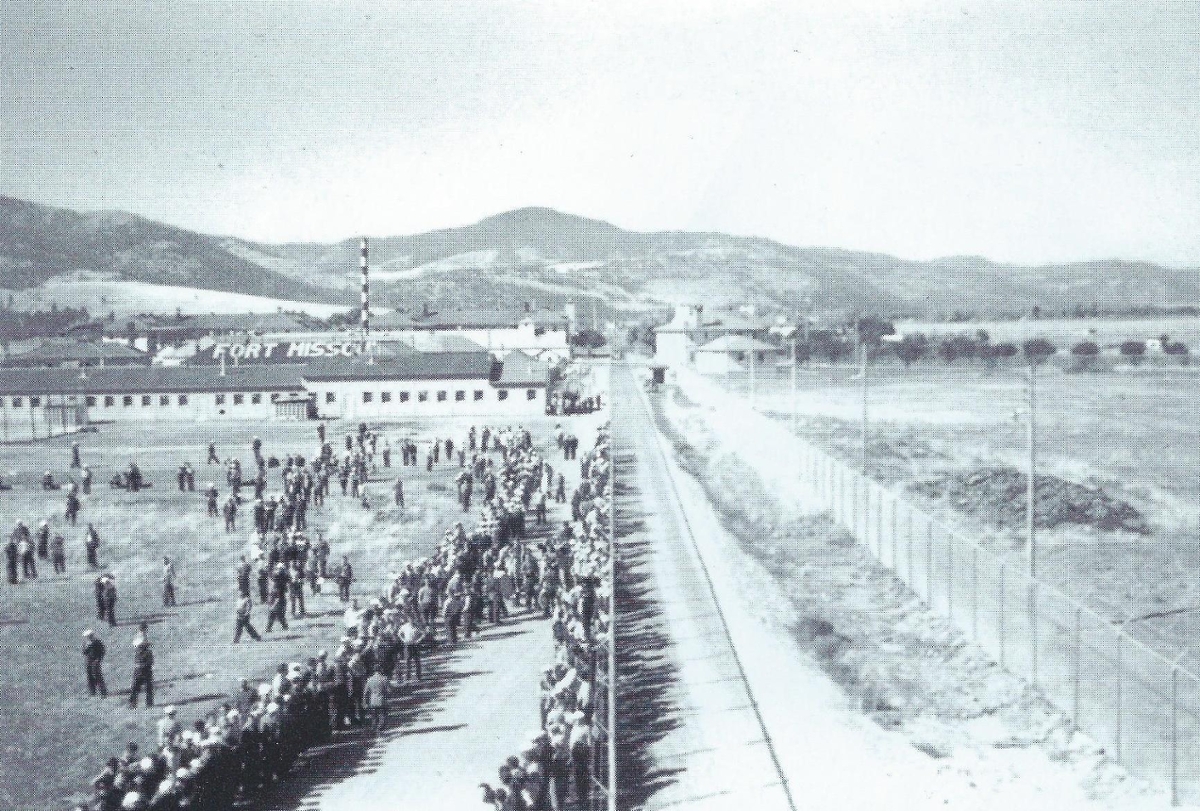Fort Missoula Camp Help Italians and Japanese During World War II
 A large group of internment prisoners arrive at Fort Missoula.
A large group of internment prisoners arrive at Fort Missoula.
When full-scale war erupted in Europe in September 1939 as Hitler’s troops marched into Poland, merchant seamen docked in U.S. ports found themselves stranded. Great Britain refused to grant safe passage home to the crews of German and Italian ships because it did not want the ships or their crews to be used in the war against them.
When the crews began to sabotage their own ships to keep them out of British hands, the men were taken off and sent first to Ellis Island and finally to detention camps in Montana and North Dakota. The Germans went to Fort Lincoln outside of Bismarck, N.D., and the Italians to Fort Missoula. About 1,000 seamen arrived at Fort Missoula in May 1941. The Immigration and Naturalization Service operated the fort and housed and fed the men, many of whom had talents in music, acting, cooking and art. The men performed chores but spent their leisure time presenting plays and musical performances, which townspeople occasionally were invited to attend.
Everything changed on Dec. 7, 1941, when Japan attacked America’s naval fleet at Pearl Harbor, Hawaii. Japan had been aggressive militarily in Asia for years, and many nations had worried how far its aggression might extend. Partly in response to that concern, FBI agents in the United States had for many months spied on Japanese living in America. Racial prejudice against Asians was long standing in the United States. First Chinese, then Japanese, were not allowed to become American citizens. They also could not own property if they were not citizens. Shunned in their adopted country, many Japanese were torn in their allegiance between their native country and their adopted home. In the eyes of the U.S. government, that made them suspect and, consequently, FBI agents began on Dec. 7 to arrest the most important Japanese alien men living in America. Within weeks they were sent by train to Fort Missoula or Fort Lincoln.
Like the Italians, the Japanese at Fort Missoula were allowed to create governing councils that were used mainly to discuss grievances with the supervisors at the fort. But they also had to perform chores like cooking, gardening, laundry and other tasks that camp supervisors oversaw. And all the men were forced to stay behind a fence topped with barbed wire and patrolled by armed guards. They could communicate by letter with their families, but their letters home were censored heavily so important details of their lives were left unreported.
Reeling from the surprise attack at Pearl Harbor, the American government worried that Japanese living in America might pass on information to Japan that would damage the U.S. or might plan attacks of sabotage. The Justice Department decided to hold hearings to question the Japanese men at Fort Missoula and to decide whether they might be disloyal. Alien Enemy Hearing Boards, consisting mainly of prominent citizens from Washington, Oregon and California, where most of the Japanese men had lived, conducted the hearings. Some Missoula residents were appointed to the boards to help with more than 1,000 hearings in the winter and spring of 1942. Most notable among those was Mike Mansfield, a professor of history at the Missoula college, then-called Montana State University.
The Japanese men were brought before the hearing officers and asked questions about trips they’d made home to Japan to see relatives, ethnic Japanese organizations they belonged to, contributions they’d made to Japanese aid societies or other activities that FBI agents had learned of during their pre-war surveillance. Most of the men were deemed a risk because the hearing officers couldn’t be sure they were not a risk, so they were not allowed their freedom.
Many of the Japanese men were transferred to other camps run by the Immigration Service and not allowed to rejoin their families until many months after the war ended, which meant five years in captivity. Usually they had lost all their possessions, including homes and businesses.
The Italians remained at Fort Missoula and, once Italy surrendered, were allowed to work in western Montana. They were needed because the war had created a severe labor shortage. A few Italians stayed in the community and lived long and productive lives, but most were sent home to Italy. No Japanese remained in Missoula after the war. The camp closed in May 1944.
University of Montana | Journalism Emeritus Professor School of Journalism | Carol Van Valkenburg
